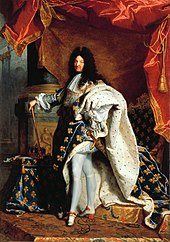Hyacinthe Rigaud


Hyacinthe Rigaud (actually Hyacinthe-François-Honoré-Mathias-Pierre Martyr-André Jean Rigau y Ros ) (born July 18, 1659 in Perpignan , France , † December 29, 1743 in Paris ) was the most important portrait painter of the French Ancien Régime .
Life
Rigaud, who became a half-orphan on his father's side at an early age, came from a family of painters and was therefore sent to Montpellier at the age of 14 to train with the less important painter Paul Pezet . He later became a student of Henri Verdier and Antoine Ranc , who mainly brought Van Dyck's painting closer to the young Rigaud . Rigaud's talent for portraiture shows up early on.
In 1681, Rigaud moved to Paris, where he initially worked in the history department at the Académie Royale . With a history painting he won the second prize of the Prix de Rome of the Academy in 1682 , which was combined with a scholarship at the branch of the Academy in Rome. His teacher Charles Lebrun , court painter to the king, convinced Rigaud, however, to give up history painting and thus the Rome scholarship that served above all and to devote himself to portrait painting. Rigaud received his first commissions from the financial bourgeoisie and the nobility . The portraits created in the process gave Rigaud considerable prestige, so that in 1688 he was commissioned by the brother of King Philip I of Orléans to do a portrait, the resounding success of which opened the doors to the high nobility, the high clergy and the crown. In 1689 he portrayed the son of Philip I who, after the death of King Louis XIV, became the Duke of Orléans as regent for the later Louis XV. has been. His best-known work is the large parade portrait of Louis XIV from 1701 (see illustration); like most portraits of the state, it was copied several times. Rigaud maintained an extensive studio with specialists for certain parts of the picture such as backgrounds, draperies or flowers, which produced portraits in an almost industrial manner, which often only have a few brushstrokes by Rigaud's hand.
He was elected a member of the academy in 1707, taught painting there from 1710 and was rector from 1733. With the rise of Nattier , however, his importance decreased and he produced less and less. One of his pupils was Jean Ranc , who later worked as a Spanish court painter.
Oeuvre and meaning
At the time, Rigaud was the undisputed star of portrait painting. Numerous portraits show that he captured not only the physiognomy , but also the character of the people portrayed with unique precision . His works, which excellently fulfilled the need for representation at the time, give us detailed information about clothing and hairstyles of the time, and they also illustrate the who's who of the era: In addition to portraits of the kings Louis XIV. , Louis XV. and Philip V of Spain , he also portrayed King August II of Poland , at the same time Elector August (the Strong) of Saxony and King Frederick IV of Denmark and Norway, Liselotte von der Pfalz (wife of Philip I the Duke of Orléans ). In addition to the aforementioned, he also made portraits of other kings of Europe, as well as other members of the French and non-French state-supporting estates. But also and especially his bourgeois portraits show the genius of his character portrayal. Most of his later works come “only” from his studio, so that an exact assignment to “his” hand is often difficult, especially since there were studio copies of many portraits. Rigaud himself wrote a catalog raisonné.
Many portrait painters orientated themselves on the works of Hyacinthe Rigaud. So also Anton Graff , who got to know his portraits during his time in Ansbach . The exemplary reproduction of the material, the velvet and the silk of the French court painter became his model.
literature
- Hans Vollmer: Rigaud, Hyacinthe . In: Hans Vollmer (Hrsg.): General lexicon of fine artists from antiquity to the present . Founded by Ulrich Thieme and Felix Becker . tape 28 : Ramsden-Rosa . EA Seemann, Leipzig 1934, p. 349-351 .
- Claude Colomer: La famille et le milieu social du peintre Rigaud (= Connaissance du Roussillon. 2). Édition Sinthe, Perpignan 1973.
- Hubertus coal, aristocratic politics. Hyacinthe Rigaud's portrait of Gaspard de Gueidan. In: Portrait, Prince and Territory. Edited by Thuringian State Museum Heidecksburg Rudolstadt by Lutz Unbehaun and others; Edit v. Andreas Beyer. Rudolstadt research on residential culture, Berlin 2000, pp. 249–266 ( archiv.ub.uni-heidelberg.de ).
- Stéphan Perreau: Hyacinthe Rigaud (1659-1743). Le peintre des rois. Nouvelles Presses du Languedoc, Montpellier 2004, ISBN 2-85998-285-X .
Web links
- Works by Hyacinthe Rigaud at Zeno.org .
Individual evidence
- ↑ Kirsten Ahrens: Hyacinthe Rigauds Staatsportrait Ludwig XIV. Typological and iconological investigation of the political message of the portrait from 1701 (= manuscripts for art history in the Wernersche Verlagsgesellschaft. ) 29. Wernersche Verlagsgesellschaft, Worms 1990, ISBN 3-88462-928-X .
- ↑ Ekhart Berckenhagen: Anton Graff - life and work. Deutscher Verlag für Kunstwissenschaft, Berlin 1967, p. 13.
| personal data | |
|---|---|
| SURNAME | Rigaud, Hyacinthe |
| ALTERNATIVE NAMES | Hyacinthe-François-Honoré-Mathias-Pierre Martyr-André Jean Rigau y Ros |
| BRIEF DESCRIPTION | Portrait painter of the French Ancien Régime |
| DATE OF BIRTH | July 18, 1659 |
| PLACE OF BIRTH | Perpignan , France |
| DATE OF DEATH | December 29, 1743 |
| Place of death | Paris |

